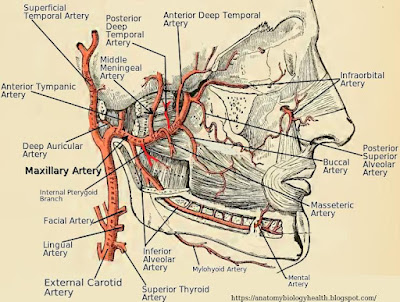The maxillary artery is one of the three blood vessels which supply the human face. The others are the transverse facial and the facial artery. It has a tortuous course and gives off important deep branches that bring oxygenated blood to the upper portion of face, middle ear, muscles of mastication, teeth and gum of mandible and maxilla, hard palate, nasal cavity, and other deep structures of face.
The maxillary artery arises from the anterior aspect of external carotid artery, at a right angle, at the level of the neck of mandible. At the beginning, it is covered by the parotid gland. Then it runs tortuously and horizontally to the front between the ramus of mandible and the sphenomandibular ligament. Next, it extends between the lateral pterygoid muscle and the temporal muscle. As it runs into the pterygopalatine fossa, it divides at the end into terminal branches.
According to the anatomical topography, the maxillary artery can be divided into three parts, or portions: 1) the mandibular portion (first part), which gives off the deep auricular, anterior tympanic, middle meningeal, and inferior alveolar artery; 2) the pterygoid portion (second part), which sends the posterior deep temporal, masseteric, buccal, and anterior deep temporal artery, as well as two pterygoid branches; 3) pterygopalatine portion (third part), which lies in the pterygopalatine fossa, giving off the posterior superior alveolar, infraorbital, descending palatine, and sphenopalatine artery.
Below, two schematic pictures of the maxillary artery and its branches.

